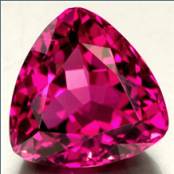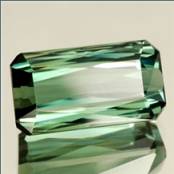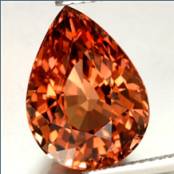GemSelect Newsletter - May 2007In our newsletter this month:
Buying anything over the Internet on the basis of a photo can be a scary experience. Will it look exactly like the photo? How can I tell what the color and size really are? What happens if I'm disappointed with the product when I get it? There are so many questions, all to be answered only when the package shows up on your doorstep, days after you've made payment. As buyers and sellers, we're all aware of the challenges of online gemstone trading. Gems are very small objects and their colors and details are extraordinarily important. So how much confidence can you have in gemstone photos? And what steps can you take to make sure you won't be disappointed when the gems are delivered? Let's start with the first question. We go to great lengths to make sure that our photos and descriptions accurately represent the gemstones we sell. It's a 3 stage process for us. First we measure and weigh each gemstone, using digital equipment accurate to the hundredth of a millimeter and carat. Then, we photograph each gem from 3 angles, using light sources that emulate natural daylight. We experiment to find the background that works best for the size, color, cut and shape of the particular gem. Then the description and photos are reviewed for accuracy by our quality assurance team. One of the most important things they do is compare the actual gemstone with the photographs to make sure the photos accurately represent the gem, in effect, simulating the moment when you first unpack the gem you purchased from us. What about the 2nd question - what steps can you take to make sure that you'll be pleased when you receive your GemSelect order? One thing you can do is check your computer monitor to see how accurately it represents color. In our experience some LCD (flat screen) monitors are set far too bright, so that a deep red stone, for example, will appear much lighter on those LCD screens. If you have a digital camera, you can check your monitor by taking some photos of your own gems and see how they appear on your monitor. You might also discover how tricky it is to take good gemstone photos! Another thing you should do is take careful note of the size of a gemstone before you buy it. When we photograph our gemstones we always try to fill the frame with the subject, so you can see as much detail as possible. But this means that a 50 carat stone will appear the same size as a 0.5 carat stone! Occasionally a customer will contact us to tell us that the stone he received was much smaller or bigger than he expected. It's actually an easy mistake to make, so take care, especially if you're new to buying gemstones online. In our 4 years' selling online, we've sold tens of thousands of gemstones and we've refined our gemstone photography. At this point we've very confident that we can represent our gemstones accurately. But in the rare case where we - or you - make a mistake, you can count on the GemSelect guarantee.
New in Gems Back to Top
Our buyers are always searching for the best value gems for our customers. Here are some of the excellent buys we've made in the last few weeks: Ametrine from Bolivia: We have just acquired some very popular violet golden ametrine gems from Bolivia. We have a large selection of pieces in a variety of interesting shapes, weighing from 2 to 15 carats. These are lovely stones at a very affordable price. Chrome Diopside from Russia: We've also just acquired a small number of pieces of exceptional chrome diopside in unusual large sizes. These rare pieces have outstanding color and clarity. Sapphire Cabochons from Thailand: We have just added some very interesting blue-green sapphire cabochons with vivid color and excellent luster. These gems weigh from about 1.8 to 3.8 carats. Rhodolite Garnet from Zimbabwe: We've added some very fine Zimbabwean rhodolite to our extensive inventory of Tanzanian pieces. The new items are in the 2-3 carat range; ideal for rings and earrings. The colors are excellent - red, pink-red and purple. Imperial Topaz from Brazil: This rich golden topaz with strong pleochroism is so popular we have trouble keeping it in stock. We've now built up a good inventory, with many pieces in the desirable 3-5 carat weight range. Citrine from Madagascar: Citrine is usually associated with Brazil, but we think the Madagascan citrine is among the best in the world. We've recently acquired some good stock in golden and yellow golden hues, weighing up to about 30 carats. We also have many pieces in the hard-to-find small sizes, so if you're looking for citrine for earrings or rings, you'll find a nice selection. Kunzite from Afghanistan: Kunzite is the pink variety of spodumene, named after the famous American gemologist, George Frederick Kunz. We rarely find kunzite, so usually we have only have a few pieces in stock. But we've recently found some excellent new pieces, with the best pink saturation we've seen in several years. These are good-sized specimens, weighing between 3 and 13 carats, in a variety of shapes. Given the superb color of these pieces, we think the price is fantastic too. Sphene from Sri Lanka: Sphene is a fairly rare gemstone that is not widely available. This is the first lot we've been able to buy in quite some time. You'll find pieces in all the different colors typical of this fascinating mineral - lively green, yellowish green, and multicolor - in a good range of shapes and sizes. Black Diamond from India: Last year we bought some natural black diamonds from India for the first time and they were incredibly popular. For months we couldn't find them again. This week we were lucky enough to find some more. We think these are very elegant gemstones - quite large for diamonds (2 to 3 carats) and nicely cut. They make stunning jewelry. Pink Tourmaline from Nigeria: We've added some very fine pieces of pink tourmaline to our extensive tourmaline inventory. There are an interesting variety of shapes and cuts, ranging from about 1 to 4 carats. Also some extremely nice red-pink and and rose pink pieces, with a few remarkable hot pink specimens. Lemon Quartz Cabochons from Brazil: These are another interesting addition to our extensive range of cabochons. These fine lemon quartz pieces come in a variety of organic shapes, weighing from 6 to 47 carats. Sky Blue Topaz Pairs from Brazil: We are pleased to announce the arrival of some lovely matching topaz pairs in a rich saturated sky blue. These are perfectly sized for earrings at 4-5 carats per pair in a brilliant, round Portuguese cut. Amethyst from Uruguay: We have found some extremely nice amethyst recently and we've bought some terrific pieces. We've added a broad range of sizes and shapes to our stock, including some impressive pieces weighing over 10 carats, some nice matching pairs and some first-rate cabochons. Agate from Brazil: We've just made some substantial additions to our stock of this fascinating mineral. We've added pieces in a wide range of colors, including amber, orange, green, blue, brown and a variety of interesting banded and multicolor pieces. There are all sorts of sizes and shapes, with some very large pieces that weigh over 80 carats. Rutile Quartz from Brazil: We've added a new selection of the fascinating rutile quartz. Our first specimens of these sold out very quickly. In case you missed it, rutile quartz is transparent quartz with inclusions of golden rutile crystals in delicate patterns. Every piece is quite unique. A favorite with collectors. Fire Opal from Mexico: Fire opal, a yellow to orange opal from Mexico, has become extremely popular. We've acquired some new stock in colors ranging from white-yellow to yellow-orange, in a wide range of sizes.
Staff Selections Back to Top
Each month our staff select some of their favorite gemstones from our inventory. This month we feature some of our recent acquisitions in Nigerian tourmaline.  2.49-Ct VS Tourmaline from Nigeria
The rubellite hues of hot pink and red have traditionally been the most valuable colors in tourmaline, and this raspberry red trillion from Nigeria is an excellent example. The brilliance and fire of this stone is nicely enhanced by the Portuguese cut.  3.29-Ct VS Tourmaline from Nigeria
Green is generally regarded as the second-most valuable tourmaline color. This lovely blue-green piece nicely displays the characteristic vitreous luster. The scissor cut works well with this long, narrow tourmaline crystal. It is a suitable size to make an impressive ring.  7.43-Ct VS Tourmaline from Nigeria
Most tourmaline deposits yield only a few different colors. This vivid orange piece shows the wide range of colors in Nigerian tourmaline. This large pear-shaped gem exhibits good brilliance, with a very attractive golden secondary tone.
Gemstones Worth Knowing Back to Top
Each month we focus on one of the lesser-known gemstones. This month's featured stone is agate.  Agate
Agate is a form of chalcedony quartz that forms in concentric layers and displays a remarkable variety of colors and textures. Agate is typically dyed to produce interesting color variations. The art of dyeing agate is believed to be an ancient one, dating back to the Romans. Agate dyeing was revived by the Germans early in the 19th century. First the agate is boiled in a strong bicarbonate solution to remove impurities. Then the stone is soaked in a chemical solution followed in some cases by heating. For example, to produce red hues, agate is soaked in an iron nitrate solution. Green is produced by immersion in a chromic acid or nickel nitrate solution. Blue is produced by a red or yellow prussiate of potassium followed by soaking in an iron sulphate solution.
Customer Questions Back to Top
Every month we answer questions of general interest from our customers. Please feel free to send your questions or suggestions to our support team at help@gemselect.com! Question
I see you have some new opal doublets on your website. What's the difference between an opal doublet and normal opal? HJ, USA.
Answer
An opal doublet is a slice of precious opal glued to a black backing. This technique is used frequently with rare opal to produce larger and stronger pieces at a lower cost. The black backing, usually made of vitriolite or common opal, also causes the color of the opal to become darker and more vibrant.
Question
Most of your gems have measurements like 6 x 4 x 3 mm. But I notice some of the gems have only two measurements, such as 6 x 3 mm. Could you explain the difference? Many thanks. TH, UK.
Answer
The measurements we give for most of our gems are length by width by depth, with the measurements in millimeters. For round gems, however, we give just two measurements, since the length and width are the same. So when you see a set of measurements like 6 x 3 mm, it's just shorthand for 6 x 6 x 3 mm.
Keep up with our new arrivals before they hit the newsletter by joining our thousands of fans and followers on our social networking pages. We love interacting with our customers - you can visit us on Tumblr, LinkedIn, Twitter, Facebook or Pinterest! To ensure you can receive our emails, please be sure to add help@gemselect.com to your list of safe contacts, or you add us into your email address book! Please feel free to contact us with any questions, comments and queries! We respond to each and every email we receive. Happy Gem Hunting! This Page in Other Languages
|
| STAY IN TOUCH | NEWSLETTER |
| *You're signing up to receive GemSelect promotional email. |
Copyright © 2005-2024 GemSelect.com all rights reserved.
Reproduction (text or graphics) without the express written consent of GemSelect.com (SETT Company Ltd.) is strictly prohibited.
176